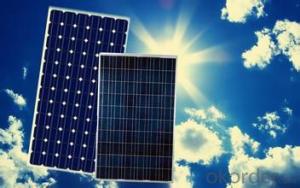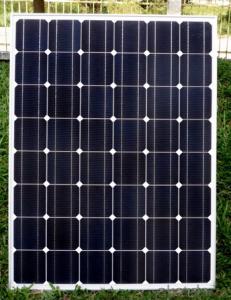24V 65W CNBM Monocrystalline Silicon Solar Panels for Home Use
- Loading Port:
- Tianjin
- Payment Terms:
- TT OR LC
- Min Order Qty:
- 100 watt
- Supply Capability:
- 1000 watt/month
OKorder Service Pledge
OKorder Financial Service
You Might Also Like
Specification
65W CNBM Monocrystalline Silicon Panel for Home Using
Production description
Emerging, third generation solar technologies use advanced thin-film cells. They produce a relatively high-efficiency conversion for the low cost compared to other solar technologies. Also, high-cost, high-efficiency, and close-packed rectangular multi-junction (MJ) cells are preferably used in solar panels on spacecraft,
The price of solar power, together with batteries for storage, has continued to fall so that in many countries it is cheaper than ordinary fossil fuel electricity from the grid (there is "grid parity"). For example in 2015, an average home in Europe or the US could use around 3,000 kilowatt-hour (kWh) in electricity each year.[1] Twelve 280 watt solar PV modules (each generating 250 kWh annually) would generate at least 3,000 kWh each year, even in a cloudy country like the UK. An example market price would be about £8,000 in the UK, $12,000 in the US, or €10,000 in theEurozone in 2015, which is certain to continually fall,[2] allowing permanent energy independence for each household. Most governments have feed-in tariff systems that allow homeowner to sell surplus energy back into the grid, and make a future profit on their investment.
Feature
1.High conversion efficiencies resulting in superior power output performance.
2.Outstanding power output even in low light or high temperature conditions
3.Optimized design for ease of soldering and lamination
4.Long-term stability,reliability and performance
5.Low breakage rate
6.Color uniformaity
7. have overseas storage for customers
8.one-stop purchase
9.give credit on reliable partner or agents
Physical characteristic
1. Rigorous quality control meets the highest international standards.
2. High-transmissivity low-iron tempered glass, strong aluminium frame.
3. Using UV-resistant silicon.
4. IS09001/14001/CE/TUV/UL
- Q: What is the main material for making solar panels?
- If you make your own, in addition to buying silicon also need to buy for the packaging of silicon photovoltaic glass and EVA film.
- Q: Can solar panels be installed on sloped roofs?
- Yes, solar panels can be installed on sloped roofs. In fact, sloped roofs are one of the most common types of roofs where solar panels are installed. The angle of the roof can be adjusted to optimize the positioning of the solar panels and increase their efficiency.
- Q: Can solar panels be installed in a desert environment?
- Yes, solar panels can be installed in a desert environment. In fact, deserts are often considered ideal locations for solar panel installations due to their high levels of sunlight and low cloud cover. The dry climate and lack of shading make it easier for solar panels to generate and harness solar energy efficiently.
- Q: Can solar panels be used for agricultural purposes?
- Yes, solar panels can be used for agricultural purposes. They can provide power for various agricultural operations such as irrigation systems, livestock watering, grain drying, and greenhouse heating. Additionally, solar panels can help farmers reduce energy costs and dependence on fossil fuels, making them a sustainable and environmentally friendly solution for the agricultural sector.
- Q: I need to reduce the average monthly home electricity bill by powering some of the household appliances using solar panels. Can I use a 250 watt solar panel to power a medium sized upright fridge?
- Solar panel alone? No. With the appropriate storage system and inverter, perhaps. You will need to do the calculation - as follows: In a solar day that averages about eight hours, you will generate about 67% of your rated output over those 8 hours. That means you will have made 340 watts. Your refrigerator will run for about four (4) hours per day on average if you are very careful about opening and closing. If you have a 400-watt (average-when-running) fridge, you will have a small cushion that will be absorbed by inverter losses, charger losses and so forth. So, with an adequate set of storage batteries, a good charger and a good inverter, you just might be able to operate that small fridge. No icemaker, no other power drains. But, two 250-watt panels would be better.
- Q: Can solar panels be installed on rooftop gardens or green roofs?
- Yes, solar panels can be installed on rooftop gardens or green roofs. In fact, these locations can provide an ideal setting for solar panel installation as they often receive ample sunlight due to their elevated position and minimal shading. Additionally, the vegetation and greenery on these rooftops can help with temperature regulation and improve the overall efficiency of the solar panels.
- Q: What are the supplies needed in a solar panel field, i know there are the panels. But what about batteries, and converters. Possibly other things, and how many will i need, for a certain amount of panels?
- I am interested also and plan on following up on the information in the next couple of weeks
- Q: There are so many solar panels and kits it is very confusing. I need to know what exactly I would need if I had an underground home with no electricity. I want to be totally off the grid with solar power. Someone please explain to me in simple terms what exactly I need. Maybe give me a link to the right kit for me. Also are they easy to install? Are there instructions that I need to download?Thank you
- You okorder ... Depending on your needs, you may have to have these customized for your home, but they at least give you an idea of what's involved.
- Q: Im doing a science project and I need to know what gases or liquids a solar panel can make that is not friendly to the environment. Please name all the gases and liquids and explain how they damage the environment. It would be most likely that you will get best answer if you find all the bad things about solar energy and explain why they are bad and how they affect nature. that would be helpful to. Thank you
- Once okorder /
- Q: What happens to solar panels during extreme weather conditions?
- Solar panels are designed to withstand a wide range of weather conditions, including extreme weather. However, during severe weather events such as hurricanes or hailstorms, there is a possibility of damage to solar panels. In such cases, the panels may become dislodged, cracked, or shattered. Regular maintenance and proper installation can help minimize the risk of damage, and many solar panels are built to withstand high winds, heavy rain, and even snow.
Send your message to us
24V 65W CNBM Monocrystalline Silicon Solar Panels for Home Use
- Loading Port:
- Tianjin
- Payment Terms:
- TT OR LC
- Min Order Qty:
- 100 watt
- Supply Capability:
- 1000 watt/month
OKorder Service Pledge
OKorder Financial Service
Similar products
Hot products
Hot Searches
Related keywords


























